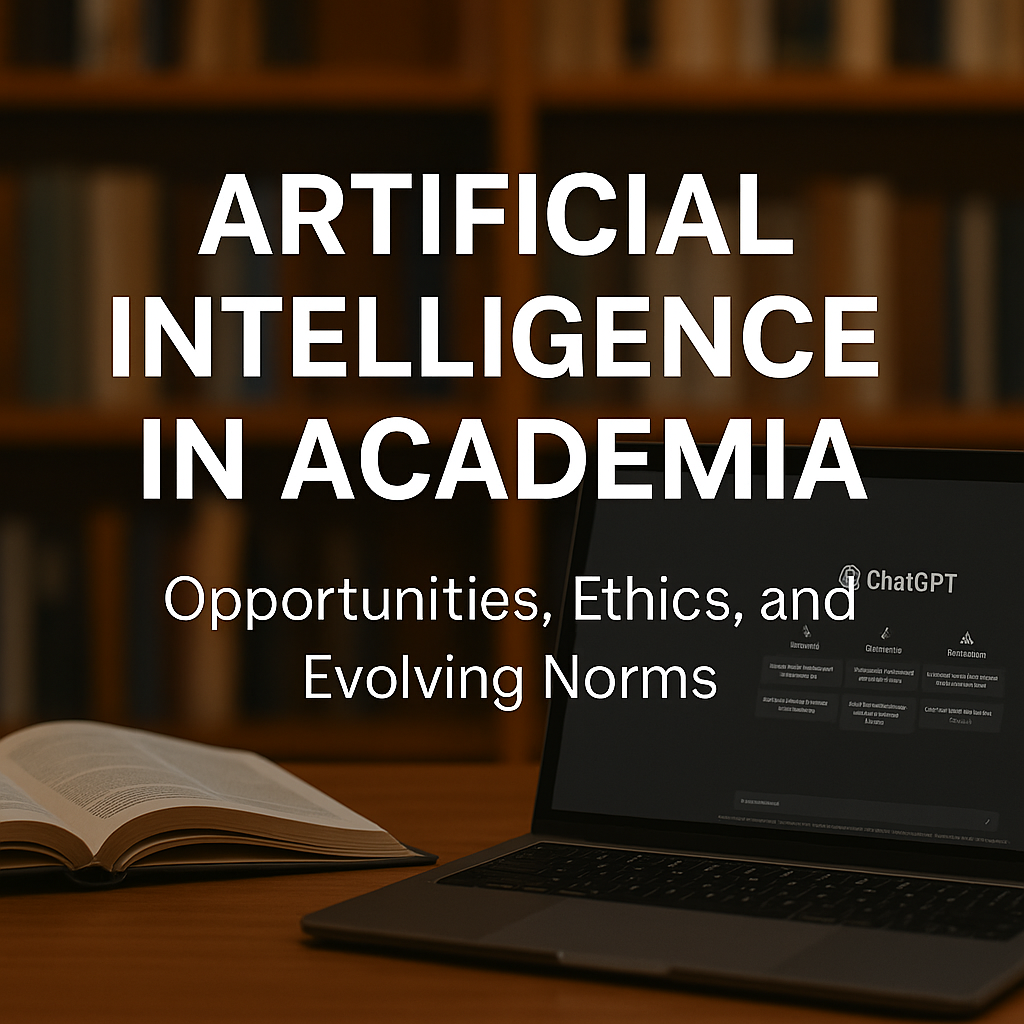Introduction
The integration of Artificial Intelligence (AI) in higher education has transformed academic landscapes across the United Kingdom and beyond. Tools such as OpenAI’s ChatGPT, GrammarlyGo, and other generative platforms are no longer novel additions—they are now central to how students draft essays, brainstorm ideas, and explore complex topics. In 2025, a report from the Higher Education Policy Institute (HEPI) revealed that over 90% of UK undergraduates have used AI tools in some form for academic work, marking a significant rise from 66% just a year earlier.
However, with this widespread adoption comes increasing scrutiny. Universities are actively updating academic integrity policies. Turnitin, a widely used plagiarism detection tool, has rolled out AI-detection technology. This advancement, while intended to uphold fairness, has sparked new ethical dilemmas. Should students be penalized for using tools that have become ubiquitous in digital education? Can Turnitin’s AI detection be trusted? And how should institutions respond to both the promise and risk of AI?
This blog explores the dual nature of AI in academia: as a facilitator of learning and as a subject of institutional caution. It examines student behavior, academic integrity concerns, university policies, and ethical usage—while offering professional advice on safe AI integration through services like Urgent Assignments Help.
The Rise of AI in Academic Life
AI adoption is not merely a technological trend—it is a reflection of evolving student needs. Generative AI allows learners to:
- Summarize journal articles quickly.
- Reframe complex theories in simpler language.
- Receive grammar and structure suggestions.
- Develop preliminary essay outlines.
These functions are especially helpful for students from non-English-speaking backgrounds, mature students returning to education, and those juggling work-study commitments.
According to a joint HEPI-Kortext 2025 survey, 88% of respondents reported using generative AI at least once during the academic year. The majority acknowledged using it to brainstorm ideas (68%), improve writing style (52%), and understand difficult concepts (49%).
Yet, this increased use is accompanied by uncertainty: What defines legitimate help versus academic misconduct? While most students use AI as a support tool, some may cross the line by submitting AI-generated text without personal input or understanding—a risky practice that can lead to severe penalties.
AI Detection: The Role of Turnitin
In April 2023, Turnitin introduced its AI Writing Detection feature, claiming over 98% accuracy in distinguishing AI-generated content from human writing. Its use has since expanded globally, with UK universities relying heavily on it during grading.
However, the tool is not without controversy. Several cases have surfaced where students were wrongly accused of misconduct due to false AI flags. A study by Stanford University in 2024 noted that AI detectors tend to misclassify non-native English writing and technical jargon as AI-generated, leading to unjust suspicion.
Additionally, Turnitin’s AI detector lacks transparency in methodology. It flags entire submissions as “highly AI-generated” based on probabilistic models but offers no insight into how scores are calculated. This opacity complicates appeals processes, especially when the stakes are high—such as in final-year dissertations.
The University of Cambridge’s internal report, leaked in late 2024, advised caution when interpreting Turnitin’s AI flags and recommended human judgment alongside automated analysis.
Thus, students must remain vigilant. Even if their intent is ethical, relying too heavily on AI-generated text increases the risk of triggering institutional red flags.
Institutional Responses and Policy Adjustments
British universities are responding in varied ways. Some, like the University of Oxford and Imperial College London, have embraced AI as a legitimate learning tool, provided students disclose its use. Others maintain stricter policies, banning AI-generated assistance in summative assessments unless explicitly approved.
The Quality Assurance Agency (QAA) released guidance titled “Reconsidering Assessment in the AI Era,” urging institutions to:
- Redesign assignments to reduce AI vulnerability.
- Train staff on AI literacy and ethical evaluation.
- Encourage authentic assessments such as oral exams and portfolios.
- Provide clear AI usage policies in module handbooks.
Interestingly, 36% of students in the HEPI survey claimed they had not received any AI-related training or guidance from their university. This gap is concerning, as students left unguided may unknowingly breach integrity rules.
By contrast, institutions such as the University of Manchester have begun offering AI literacy workshops, promoting responsible use while setting boundaries. This hybrid approach balances innovation with integrity, helping students use technology without overstepping academic norms.
Ethical and Psychological Implications
Beyond institutional rules, students face personal dilemmas. Is it morally acceptable to use AI to generate ideas? Should they paraphrase AI-generated summaries without citation?
The issue becomes more complex when students consider fairness. Some may feel disadvantaged if others use AI to complete work faster. Others worry about losing their voice and analytical skills. In fact, many UK students have expressed concerns over long-term dependency on AI, especially in disciplines like philosophy, history, or political science that demand critical thinking and original arguments.
Moreover, there’s rising anxiety around AI detection. Even students who write their work manually but use Grammarly or ChatGPT for checking risk being flagged unfairly. This climate of suspicion breeds fear and damages student confidence.
The University of Leeds surveyed its postgraduate cohort in January 2025 and found that 27% avoided AI altogether due to fear of Turnitin penalties—even when AI might have helped them learn more effectively. This chilling effect suggests a need for clearer communication and support.
International Perspectives and Lessons
AI integration in academia is not unique to the UK. Globally, universities are facing similar challenges.
- United States: Harvard and Stanford have both issued AI inclusion policies, promoting transparency and originality but allowing AI as a thinking partner.
- Australia: The University of Sydney now requires students to declare AI tools used in assignment appendices.
- Singapore: Institutions have developed AI sandbox platforms where students can experiment under guided supervision.
UK universities can learn from these models. Rather than adopting a punitive stance, fostering an environment of ethical experimentation and learning may empower students rather than alienate them.
How Students Can Safely Use AI
To navigate this complex space, students should:
- Understand Their University Policy
Each university sets its own guidelines. Read assignment briefs carefully and seek clarification on AI usage. - Avoid Overdependence
Use AI to explore ideas—not to write entire assignments. Ensure your personal voice and analysis remain central. - Cite When in Doubt
If AI is used for summarizing or ideation, consider acknowledging the tool used, either in a footnote or appendix. - Use Human Proofreading
AI may miss context, nuance, or academic formatting. Have your work reviewed by a peer, tutor, or professional service. - Avoid AI Detectors for Reassurance
These tools are inconsistent and often misleading. Focus on learning and originality rather than trying to “trick” Turnitin.
A Smarter Way Forward
AI is here to stay. Instead of resisting its presence, academia must find ways to coexist with it responsibly. This means:
- Designing assessments that reward process over product.
- Educating students about ethical AI use.
- Training staff to differentiate between intentional misconduct and technological support.
- Updating integrity policies to reflect the realities of digital education.
Likewise, students must view AI as a support tool, not a shortcut. Overreliance leads to skill degradation, undermining the very purpose of education.
Professional Guidance for Students
If you’re a student unsure how to ethically integrate AI into your assignments, our team at Urgent Assignments Help is here to assist. We specialize in academic consultancy, plagiarism-free content, and compliance with university guidelines.
From essay support to dissertation assistance, we offer tailored help that respects both technological advancement and academic standards. We understand how institutions evaluate AI usage, and we can guide you to use tools wisely, safely, and effectively.
📱 Contact us now on WhatsApp for instant support. Whether you’re stuck with a difficult topic or concerned about AI flags, we’re here to help.
Conclusion
Artificial Intelligence has emerged as both a solution and a challenge in modern academia. For UK students, it offers unprecedented learning support—but also poses ethical, procedural, and psychological complexities. Universities are adjusting policies, tools like Turnitin are increasing detection accuracy, and the conversation around AI ethics is evolving rapidly.
In this evolving landscape, students must act cautiously. Understanding policies, using AI responsibly, and seeking professional guidance are no longer optional—they’re essential for academic success. Institutions, in turn, must provide frameworks that uphold integrity without stifling innovation.
As we move further into the age of AI, one thing is clear: education is no longer just about what you know—but how you learn, think, and adapt.



